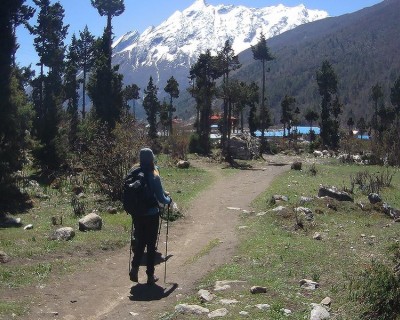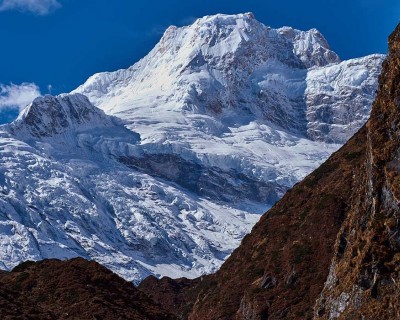How Difficult is the Manaslu Circuit Tsum Valley Trek?
General Difficulty Level (Moderate to Challenging)
To put it in simple words, Manaslu Circuit Tsum Valley Trek difficulty sits in the moderate to complex category by Himalayan standards. This journey is slightly more demanding than the Annapurna Circuit Trek, but not technically challenging like climbing Island Peak or Amphu Laptsa.
Unlike the Everest and Annapurna regions, which benefit from decades of commercial development, the Manaslu region remains comparatively untouched. Due to which the difficulty of Manaslu Circuit Tsum Valley Trek is shaped by a combination of altitude, remoteness, terrain complexity and sheer length of the trek.
At a glance, this trek spans approximately 230 km (143 miles). This trek also includes a cumulative ascent of over 3,706 meters (12,158 feet). The trail gradually increases in difficulty as you move from the subtropical forest to high alpine zones. What makes this trek uniquely challenging is the combination of high-altitude exposure and consistent physical efforts for over two weeks.
Combined Difficulty of Both Regions
Each region presents its own unique demands, that is universal among these serene routes as well. The Tsum Valley Trek is often romanticized for its isolation and Buddhist heritage.It presents a more mentally challenging leg out of two. The villages in this valley are farther apart and the trail becomes rugged, narrow and at times crosses the landslide-prone regions.
You will find fewer teahouses, more rustic lodges and longer stretches between the resupply points. In contrast to that, the Manaslu Circuit Trek is better developed, but it still pushes the physiological limits. Trekkers need to deal with thinner air, colder temperatures and increased risk of Acute Mountain Sickness (AMS).
The combination of these two areas results in a trek that demands more than just good lungs and strong legs. To conquer this less-traveled region in the Himalayas, you will need proper planning, patience and resilience.

Physical Fitness and Experience Requirements
Ideal Fitness Level for Trekkers
To overcome the Manaslu Circuit Tsum Valley Trek difficulty, physical proficiency is non-negotiable. This isn’t a casual hike, it is a high-altitude journey that lasts multiple days. It demands solid cardiovascular health, lower-body strength and above all, a good level of stamina. Trekkers need to be in good physical condition to handle 5 to 7 hours of walking per day.
The terrain is often steep, uneven and rises to high elevations where oxygen levels are significantly lower. You don’t need to be an ultramarathoner to do this trek. But a typical trekker should be able to do:
- Walk 15 to 20 km per day with a backpack weighing 6 to 8 kg on average
- Following a steep climb, the trail jumps 1,000 meters in a single day while crossing Larkya La Pass
- Should be able to function and walk the trail consistently, covering the average distance
- Trekkers should be capable of meeting the daily quota with reduced sleep and appetite due to altitude effects
Recommended Trekking Experience (Especially for Beginners)
While a beginner can complete this duo route exploration with determination, it is not recommended as a first-ever trek. Unless you have a strong guide team and have trained extensively for the journey. Previous trekking experience in routes such as Langtang Valley, Annapurna Base Camp, or Khopra Ridge would provide an ideal foundation.
If you have previous trekking experience, you will understand how your body reacts to altitude. You will be familiar with pacing, hydration and layering for the temperature shifts. Furthermore, you will also understand the mental effort of continuous trekking days on demanding terrain.
You are recommended to do at least one 4- 5 day trek with elevation points of 2,500 to 3,500 meters beforehand if you don’t have any prior experience. That alone can drastically reduce your chance of suffering from AMS. At the same time, it also increases your confidence in long and remote routes like the Manaslu Circuit Tsum Valley Trek.
Trek Duration and Daily Walking Hours
Typical Itinerary Length (18-20 Days)
The full Manaslu Circuit and Tsum Valley Trek spans around 18 to 21 days. Duration of your trip will be determined by your pace, acclimatization plan and contingency days for weather and fatigue. Tsum Valley Trek extension adds around 5 to 7 days to the Manaslu Circuit Trek itinerary plan.
As for the Manaslu Circuit Trek alone, it can be completed within the frame of 12 to 14 days. Although fit trekkers can go for the shorter treks, if you prefer a relaxed pace, you need to go for the longer option. Trekking hours during this trek depend on the portion you are navigating. It is not just about covering the distance. Acclimatization, weather flexibility and energy management aspects need to be considered for a relaxed schedule.
- Standard itinerary duration without Tsum Valley: 12 to 14 days
- With Tsum Valley extension: 18 to 21 days
- Faster trekkers with strong fitness may complete below an 18-day period, but that compresses rest and risks altitude-related issues
Daily Distance and Hours of Walking
During this duo route exploration, you will walk an average distance of 10 to 20 km per day. Depending on the terrain and altitude, it is approximately 5 to 7 hours of trekking each day. Some days, like while crossing Larkya La Pass, you will need to walk for 8 to 10 hours.
Here is a summary of daily distance and hours of walking during this trek:
- In the lower Manaslu and Tsum region: 12 to 20km on average per day, 6 to 7 hours of walking
- Higher Manaslu region: 10 to 15km on average per day, 6 to 8 hours of walking
- Larkya La Crossing: 8 to 10 hours of walking over snow and rocky terrain. You need to start as early as 3:00 A.M.
These are demanding but sustainable hours. As porters will assist with heavy gear and luggage, each day’s trek will be manageable and less taxing.
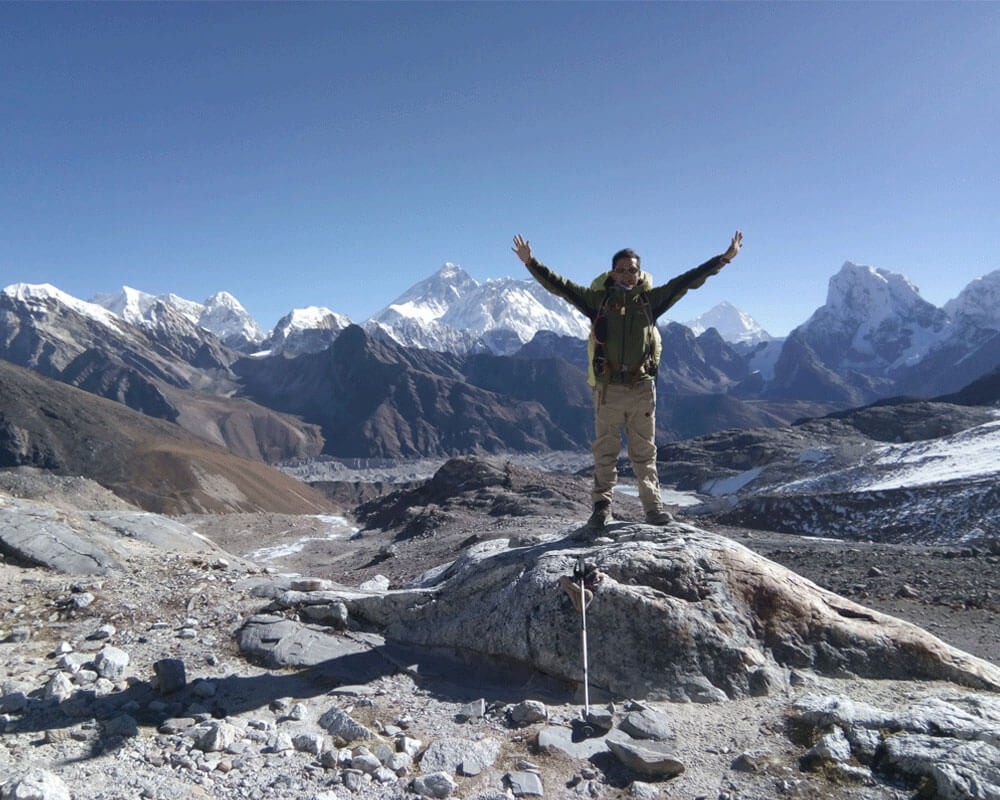
Altitude and Acclimatization Challenges
Highest Point: Larkya La Pass (5,160m)
One of the majorly challenging portions and highlights of the Manaslu Circuit Tsum Valley Trek difficulty is Larkya La Pass. This pass sits at 5,106 meters (16,752 feet) and is exposed and snow-covered. At this altitude oxygen level drops drastically.
It is approximately 50% to 55% of the sea level. The wind chill can push the temperatures below freezing point in the early morning (-15°C or lower). Even with good acclimatization, headache, nausea and shortness of breath are common at such elevation.
That’s why crossing the pass safely requires proper timing. You will start climbing the pass route before dawn and move slowly but steadily. It is very important to keep yourself warm and stay hydrated as well.
Risks of AMS and Acclimatization Strategy
As this trek stretches over major elevation points, the tisk of Acute Mountain Sickness (AMS) is quite real. Even trekkers with a good fitness level may show symptoms like nausea, headache, insomnia, loss of appetite, shortness of breath, etc.
Although there is no visible risk of HAPE and HACE in this route, ignoring minor symptoms, AMS can take an ugly turn. The Manaslu-Tsum combination adds risk because you ascend gradually through Tsum Valley. Then dip down before ascending sharply to Larkya la pass. Thus, it can disrupt the natural acclimatization if rushed.
Here are some preventive acclimatization tips:
- Climb high and sleep low
- Select a slow-paced package with a sufficient acclimatization period
- Stay hydrated, avoid alcohol and monitor symptoms daily
- Eat a balanced diet and keep yourself warm
- It is best to avoid gaining more than 500 meters of sleep elevation per day at higher regions (above 3,000 meters)
- Consider taking altitude sickness medication like Diamox (consult with doctor first)
Trail Conditions and Terrain Difficulty
Steep Ascents/descents, Narrow Paths, Suspension Bridges
Another major factor to be mindful of in the Manaslu Circuit Tsum Valley Trek difficulty is the nature of the terrain. From the very first starting portion of the trek (Machha Khola), trekkers encounter long and steep ascents. They will also need to traverse across the narrow descents carved into the cliff face or ancient stone steps.
This gradient pattern of the trail continues throughout the journey, especially along the Budhi Gandaki River gorge. It is not uncommon to gain and lose over 500 meters of elevation in a single day. This factor is prominently noticeable during the early and mid-sections. The narrow paths, particularly between Jagat and Deng and later in Tsum Valley beyond Chhokangparo, test both balance and nerve.
Suspension bridges span the deepest gorges. Some are long and swinging while others are old and creaky. They are structurally sound, but they do challenge those with a fear of heights. These route elements are not avoidable, they are an integral part of the trail.
Trail Quality in Different Seasons
The Manaslu Circuit and Tsum Valley Trekking trail fluctuates drastically depending on the season and the weather patterns. In the autumn season (September to November), trails are dry, visibility is excellent and river crossings are safer. Autumn is the best period for stable footing and clear navigation.
Spring (March to May) also offers a similar level of favorable conditions. However, snowmelt in the higher region can lead to some soggy patches and swollen streams. During monsoon (June to September), the trail completely transforms. Rain turns dry path into muddy trenches, stones are slick and slippery and moss-leeches infest the lower jungle routes.
As for winter (December to February), it coats the higher part of the trail with ice and snow. In deep winter, the trails beyond Samdo may be buried with snow and approaching Larkya La is dangerous.
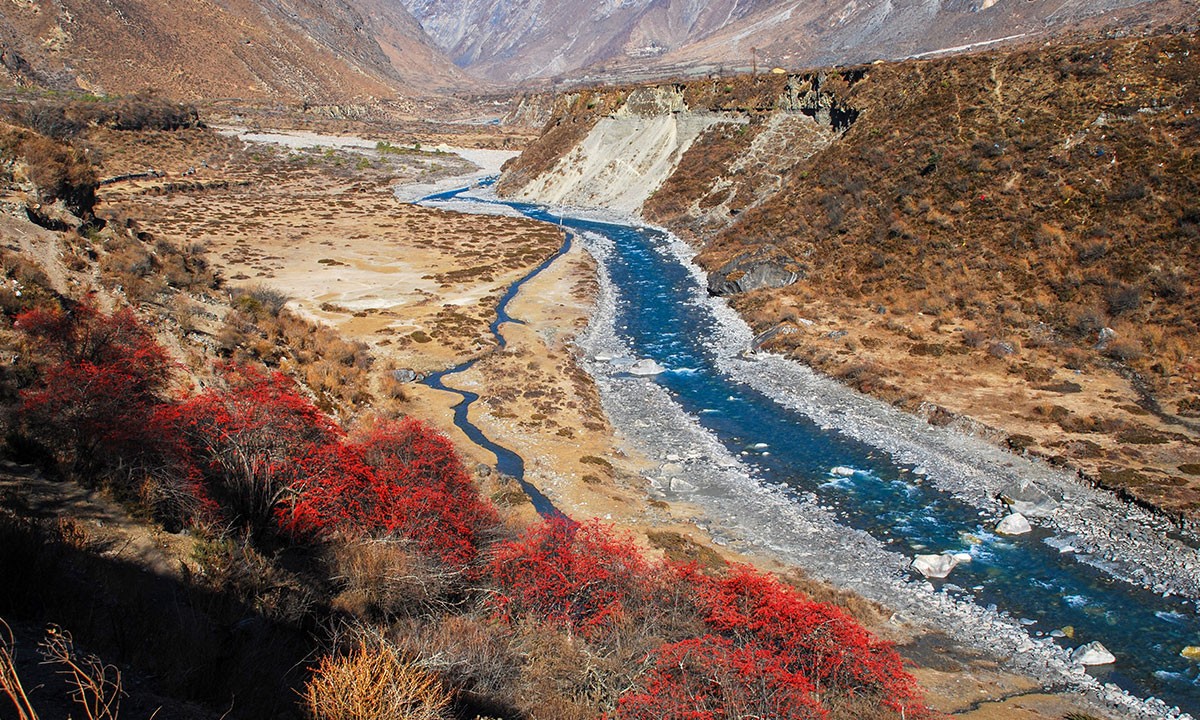
Weather and Seasonal Difficulty Factors
Best Trekking Seasons vs. Off-season Risks
The ultimate periods to enjoy the best of these duo quiet and tranquil routes are autumn (September to November) and spring (March to May). These seasons offer the most stable weather, safest trail conditions and best high-altitude visibility. Spring and autumn also coincide with clear skies, dry air and minimal precipitation.
So, navigating across this demanding trail and crossing Larkya La Pass is more feasible. The overall journey becomes more manageable. Outside these peak periods risk escalates. The monsoon season (June to September) brings relentless rain, dense clouds, poor trail visibility and landslide danger.
In winter, extreme cold, snow accumulation and icy winds can make the higher regions and Larkya La treacherous. Villages above 3,500 meters begin to shut down and logistic support becomes minimal. Only very well-equipped and experienced trekkers can attempt this duo valley exploration in off periods.
Temperature Ranges, Snow and Rainfall Issues
The elevation of the Manaslu-Tsum region spans from 870 meters to over 5,100 meters. Trekkers will move through multiple climatic zones. At the lower part of the trail, it is warm and humid. Temperatures average around 15°C to 25°C in the warmer seasons. And, nighttime temperatures can drop upto 5°C to 10°C.
At the mid-elevation, daytime temperatures usually hover at 8°C to 15°C. As for the night temperature, it can reach 5°C to -2°C in the chilly months. As for the regions near and above alpine zones, temperatures range about -10°C to -15°C at night. On the Larkya La Pass, early morning crossing may see temperatures drop below -15°C.
Rainfall is highest during the monsoon season. As for snowfall, it can start as early as the beginning of November and linger in the early part of spring. Even light snow can drastically alter the difficulty level of the trail. It makes traversing rocky and exposed sections more dangerous.
Remoteness and Limited Infrastructure
Limited Access to Hospitals and Communication
The Manaslu and Tsum Valley trails are very farther from major medical services. Once you leave Machha Khola, there are no real hospitals along the way. You will only find basic health posts in the villages like Philim and Samagaun. These medical posts can only offer basic treatment.
In an emergency, helicopter evacuation is the only viable rescue option. As for communication options, mobile networks are limited in this region. NTC has better coverage than Ncell. But the signal can be unreliable. In the Tsum Valley, there is virtually no network coverage after crossing Chumling.
Fewer Teahouses in Tsum Valley vs Manaslu Circuit
The Manslu Circuit has been slowly developing its infrastructure. Most major stops along the way have at least a few teahouses that offer basic food and accommodation. The accommodation remains rustic, except thin blankets, a shared bathroom and limited options on the menu. But, even in your remote exploration, you will find a bed, hot food and a place to charge your devices.
In contrast, Tsum Valley remains significantly less developed. From Chhokangparo to Mu Gompa, there are only a few teahouses. And, even among them, many operate seasonally or as family-run homestays. Food option at such teahouses is often limited to local staples.
Mental Challenges and Trekking Endurance
Isolation and Long Stretches Without Connectivity
This lengthy Himalayan adventure is not a test of legs and lungs. It i also a profound mental challenge. Once you leave the bustling city life, you will enter one of the most secluded trekking corridors in Nepal. Tsum Valley particular, takes isolation to another level. Mobile networks are limited and Wi Fi is unavailable in most villages.
You may go days without having any digital contact. Those who are not used to remote travel may face anxiety, loneliness and vulnerability due to this isolation. Villages are small and interactions are limited and the sense of detachment intensified as you climb higher.
This solitude can be meditative for some while emotionally taxing for others. Trekkers need to prepare themselves for the silence slow rhythm of remote life and complete disconnection from the online world.
Dealing With Fatigue and Psychological Stamina
Trekking for 18 to 21 days through rough mountain terrain is an endurance game. Not just muscular but psychological as well. The multi-hour walking, high altitude headache, aching legs, basic food and cold nights will wear you down over time. While traversing the higher part of the trail, mental fatigue becomes more intense than physical exhaustion.
The solution is not to suppress it, but to acknowledge these aspects and prepare for it. Learn to manage discomfort, celebrate small wins and reframe each hurdle along the way as part of a transformative journey.
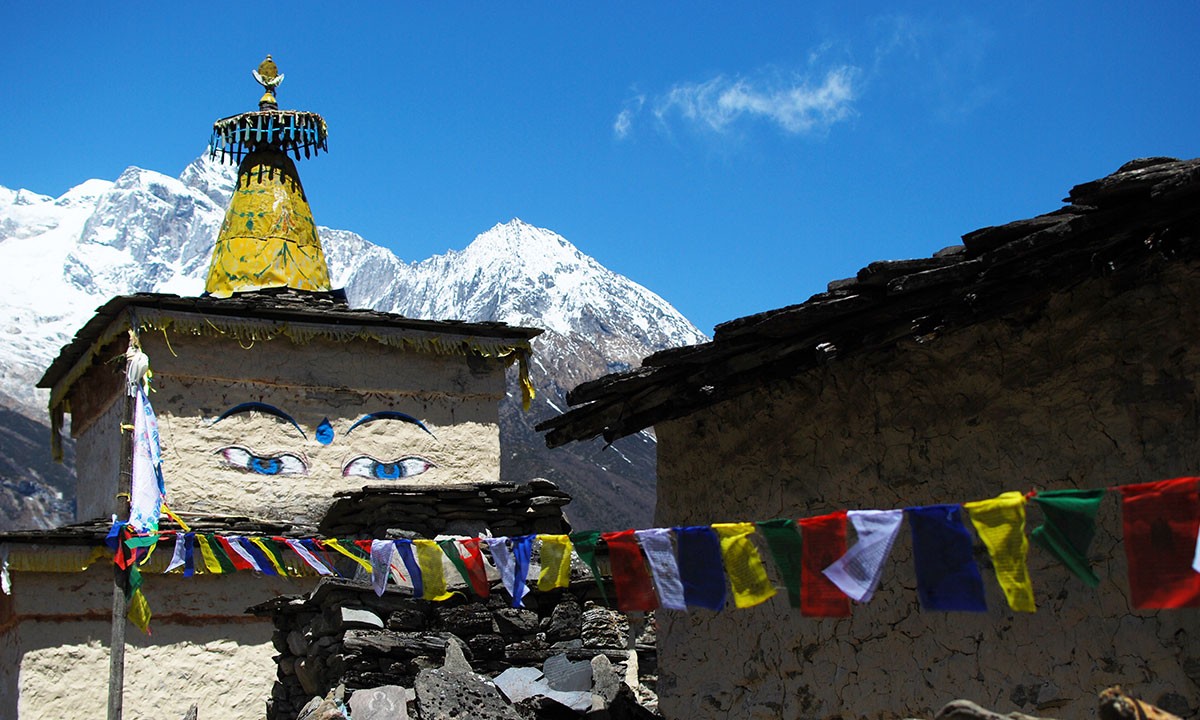
Training Tips to Prepare for the Trek
Pre-trek Fitness Routine
To prepare for the Manaslu Circuit Tsum Valley Trek difficulty, your training must go beyond casual jogging or weekend hikes. You are not preparing for a one-day challenge but continuous exertion under variable conditions like cold, fatigue and high altitude. An effective 8 to 12-week pre-trek training plan will be most fruitful.
You should focus your training around endurance, strength, cardiovascular conditions, flexibility and recovery. Trekking with a loaded backpack is different from gym cardio. Load-bearing hikes on uneven trails are the best way to simulate the actual trek. You should include it in your pre-trek training to prepare your body for real conditions.
Mental Preparation and Gear Familiarity
Mental readiness isn’t abstract; its fortitude lies in rehearsal and visualization. To overcome the mental barriers, you need to understand the psychological demands of the journey. You need to then decide on your response strategy to the hurdles along the way. Brace yourself for the freezing nights, high altitudes, rough roads, remoteness and exhaustion.
Gear familiarity is also equally important. Don’t wait till Day 1 of the trek to break in your boots or try that new backpack. Make sure to test everything beforehand. Muscle memory and gear confidence reduce mental load on the trekking trail. The fewer things you are uncertain about during the trek, the more mental energy you will conserve for awareness and endurance.







